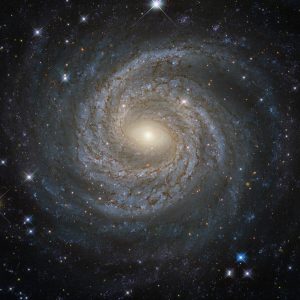
![]() In 1960, the Sierra Club published This is the American Earth, the first in a series of “exhibition format” books that would launch the club onto a national stage. Although largely featuring western landscapes by Ansel Adams, the first section of the book, “Brief Tenant,” opened with a Palomar Observatory photograph of a spiral nebula that placed the “American Earth” into a galactic context. The text by Nancy Newhall tried to give poetic form to galactic creation: “In myth, in dream, this living dust remembers chaos, the drift through endless night, the longing to cohere,—the shock, the winds, the vast light of Creation. Was it seven billion years ago this planet formed from a cosmic cloud?”[footnote]Ansel Adams and Nancy Newhall, This is the American Earth (San Francisco: Sierra Club, 1960), n.p.[/footnote]
In 1960, the Sierra Club published This is the American Earth, the first in a series of “exhibition format” books that would launch the club onto a national stage. Although largely featuring western landscapes by Ansel Adams, the first section of the book, “Brief Tenant,” opened with a Palomar Observatory photograph of a spiral nebula that placed the “American Earth” into a galactic context. The text by Nancy Newhall tried to give poetic form to galactic creation: “In myth, in dream, this living dust remembers chaos, the drift through endless night, the longing to cohere,—the shock, the winds, the vast light of Creation. Was it seven billion years ago this planet formed from a cosmic cloud?”[footnote]Ansel Adams and Nancy Newhall, This is the American Earth (San Francisco: Sierra Club, 1960), n.p.[/footnote]
While Adams and Newhall could use a photograph of a spiral galaxy to stand in for the creation of the entire universe, in fact each spiral galaxy is unique. The spiral galaxy known to astronomers as M 6814, photographed by Hubble in May 2016, is a type of galaxy called a “Seyfert galaxy,” typified by very active centers that emit strong bursts of radiation. According to NASA, scientists suspect that the center of M 6814 is the home of a supermassive black hole with a mass about 18 million times that of the sun.[footnote]”Hubble Spies a Spiral Snowflake,” May 13, 2016. https://sites.middlebury.edu/landandlens/ Accessed February 17, 2017.[/footnote] In the large clouds of gas that make up its arms are many newly formed blue stars.
In her fascinating book, Picturing the Cosmos: Hubble Space Telescope Images and the Astronomical Sublime, Elizabeth Kessler argues that the astronomers and image processors who first established the look of Hubble-generated images were strongly influenced by paintings of the American West by Albert Bierstadt and Thomas Moran, among others, as well as photographs of sublime mountains and deserts by nineteenth-century frontier photographers such as Timothy O’Sullivan. Moreover, she documents how the Hubble Heritage Project members admired the work of Ansel Adams, even nick-naming a set of black and white Hubble images the “Ansel Adams Gallery.”[footnote]Elizabeth A. Kessler, Picturing the Cosmos: Hubble Space Telescope Images and the Astronomical Sublime (Minneapolis: University of Minnesota Press, 2012), p. 55.[/footnote] She argues that the notion of the sublime, so important for nineteenth-century landscape art, has been recast by Hubble images into a visual language of the “astronomical sublime,” codified in awe-inspiring views of a vast, expanding universe.
Listen and watch as Professor Frank Winkler and Jonathan Kemp discuss this photograph: